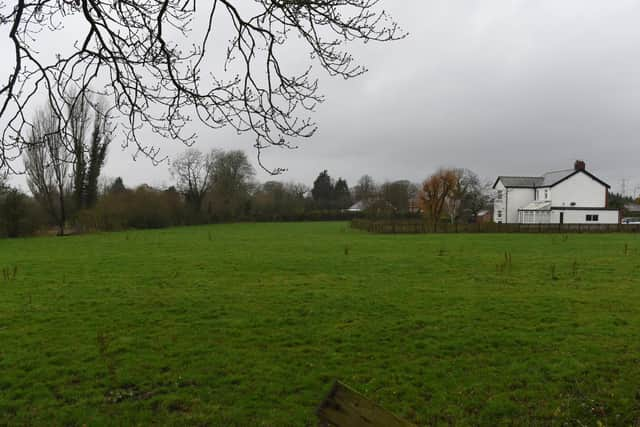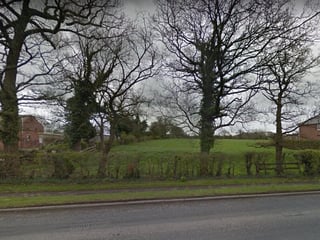South Ribble village development rejected once again
and live on Freeview channel 276
The bid by Wainhomes to build on what has become a pivotal plot off Chain House Lane in Whitestake was first rejected by South Ribble Borough Council’s planning committee 18 months ago – because the site is identified as “safeguarded land” within the authority’s local plan.
That means it has not yet been released for development – although it may be made available for housing at some point in the future.
Advertisement
Hide AdAdvertisement
Hide AdThe decision was upheld by a planning inspector late last year after the firm appealed – but it was subsequently overturned by a High Court judge back in August. The outcome of the case means another planning inquiry will have to be held, with the matter now due to be assessed before a new inspector next March.


However, Wainhomes also submitted a fresh application to the authority, which has once again been thrown out by councillors.
The site has become a crucial link in determining how housing need should be calculated across South Ribble and neighbouring Preston and Chorley.
The planning inspector who considered the case last year concluded that the three Central Lancashire authorities – who have co-operated over housebuilding numbers for almost a decade – should base their annual requirements on the so-called “standard method” introduced by the government in 2019.
Advertisement
Hide AdAdvertisement
Hide AdThat reduced the annual collective minimum housing need across the three boroughs from 1,341 – a figure dating back to 2012 – down to 1,010. The inspector found that the earlier figure was out-of-date, because it was over five years’ old and had not been formally reviewed.
Under an agreement between the trio to pool and redistribute their housing targets, that would enable each of them to demonstrate the five-year supply of available housing land demanded by the government.
However, the High Court judge who heard the appeal case ruled that the planning inspector was flawed in her reasoning – and, crucially, that she had not considered the impact of applying the standard method on the redistribution of new dwellings between the three councils, rendering South Ribble’s policy on safeguarded land out-of-date as a result.
A report to the planning committee stated that the authority was currently still basing its housing need on the standard method – giving it an annual requirement for 191 homes, for which it could show it had sufficient land.
Advertisement
Hide AdAdvertisement
Hide AdHowever, in order to recommend refusal of the application in light of the out-of-date safeguarded land policy, the council had to go through a so-called “tilted balance” exercise – to show that the adverse impacts of allowing sustainable development, even on land not earmarked for the purpose, would “significantly outweigh” any benefits.
Members were told that “significant weight” could still be attached to the safeguarded status of the land, even though the policy on which it was based was considered out-of-date – chiefly, because it was not required in order to show South Ribble had enough land to meet its housing need.
However the committee was also told that the council did not consider the site sustainable in the first place.
“It is still a disconnected pocket of housing, away from the major urban sites,” said planning officer Catherine Lewis.
Advertisement
Hide AdAdvertisement
Hide AdThe developer argued that the location was “accessible” – and committed to funding a bus service for five years, as well as noting the benefits which would accrue from additional council tax and community infrastructure payments.
However, residents who queued up to criticise the plans were more concerned with what they saw as the adverse impact of the proposal on their lives and the area. Ninety objections were lodged and more than 1,200 people signed a petition opposing the estate.
Campaigner Jean Berry questioned statistics presented in the application showing no accidents in the vicinity over a four-year period, revealing that a freedom of information request to the police had actually identified a total of 41 between 2013 and 2017.
She added: “Peak-time traffic is usually backed up from the A582, past the access point to the site and onto Church Lane and Coote Lane. Accidents in the wider area bring chaos for hours…and total gridlock.”
Advertisement
Hide AdAdvertisement
Hide AdLocal resident Joanna O’Connor stated that the plan would “significantly change the character of the area from being an agricultural site to “a built-up area that overshadows the existing properties”, while concerns were also raised about the potential for flooding and the loss of important hedgerows.
Farington West ward councillor Karen Walton said that other large developments in the area meant that there was an even greater need to protect safeguarded land, “which creates green lungs between the large housing developments, so ensuring the permanence of the greenbelt”.
Although no statutory bodies – including the highways and environment authorities – objected to the proposals, committee members were unconvinced.
The application was unanimously refused, but a planning inspector looks set to have the final say when the new inquiry begins next year.
HOUSEBUILDING BINGO
Advertisement
Hide AdAdvertisement
Hide AdThe number of houses that should be built in each part of Central Lancashire every year varies widely depending on the policy on which the calculations are based.
A “memorandum of understanding” between Preston, Chorley and South Ribble councils, which was renewed only in April, split the region’s housing requirement by considering Preston and South Ribble’s housing commitments under the City Deal, as well as the large amount of greenbelt in Chorley, giving rise to the following shares:
Preston – 404
South Ribble – 328
Chorley – 278
However, that agreement has since been undermined by the ruling of a planning inspector assessing a proposed development in Chorley, leading Preston to withdraw from it. Under a non-redistributed system, the split changes to:
Chorley – 569
Preston – 250
South Ribble – 191
WHY A PLANNING APPLICATION IN SOUTH RIBBLE MATTERS IN PRESTON AND CHORLEY
Advertisement
Hide AdAdvertisement
Hide AdWhen the planning inspector in the Chain House Lane case concluded in late 2019 that Central Lancashire's three district councils should be using the government's "standard method" for calculating housing need, the reduced figure that it introduced for Preston meant that the city council was able to show that it had five years' worth of land set aside for housing - the first time it had been able to do so in almost two years.
As a result, the authority was no longer obliged to approve proposals for sustainable development on land that it had not reserved for that purpose. It enabled the council to reconsider - and refuse - previously-approved bids for 944 homes in villages to the north of Preston, some in areas of open countryside. Most of them had been left in limbo after their initial approval by councillors, while the government considered whether to call them in for further consideration at the request of Wyre and Preston North MP Ben Wallace.
Even after the High Court ruling overturning the planning inspector's conclusion in Chain House Lane case, Preston has continued to hold itself to the lower annual housebuilding figure. However, it has withdrawn from the agreement to pool the sub-regional target between the three authorities after that was given "limited weight" in a separate planning inspectorate ruling over an application for an estate on Pear Tree Lane in Chorley. The effect has been to reduce the city's minimum annual housing requirement even further, as shown in the figures above.
Preston and South Ribble can demonstrate five-year supplies of land whichever figure is used, but Chorley is unable to do so - meaning that the borough is currently wrestling with the kind of applications for development on land not reserved for housing which have faced its neighbouring authorities in recent years.
Redrow was last month accused of lodging "speculative" applications to build over 300 homes on safeguarded land in Eccleston and Whittle-le-Woods.
Comment Guidelines
National World encourages reader discussion on our stories. User feedback, insights and back-and-forth exchanges add a rich layer of context to reporting. Please review our Community Guidelines before commenting.
